Since the late nineteenth century, the Vietnam train has played a significant role in Vietnam’s cultural and economic development. Today, Vietnam’s railway network provides passengers with a distinctive and historically important form of transportation for exploring the country’s diverse landscapes and cultures.
In this article, we’ll take you on a train ride through Vietnam, demonstrating how to use the railway system, what to expect on board, and what attractions to see along the way. Join us as we travel by rail across Vietnam’s rich cultural history and gorgeous beauty. All aboard!
See more: Discover Vietnam Transportation
Contents
The History of Vietnam Train
The railway’s introduction in Vietnam was a historic event in the country’s social and economic development. The French colonial administration built the first railroad in 1881, connecting Saigon with My Tho in the Mekong Delta region.
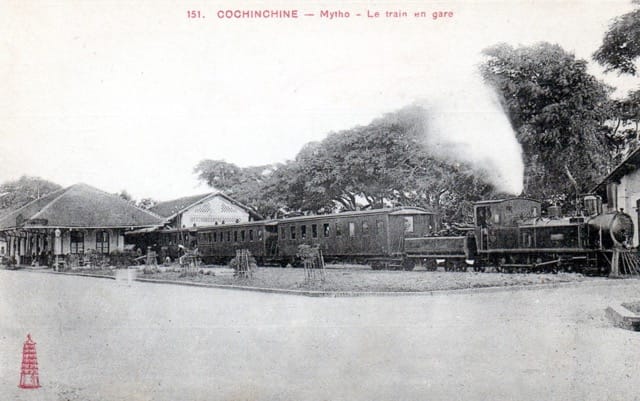
The railway was initially established to convey rice and other agricultural products from the delta to the port of Saigon. Still, it quickly grew to incorporate passenger services, connecting significant towns and cities across the country.
The construction of the North-South railway line in the 1930s was a significant milestone in Vietnam’s railway history. The railroad, which stretches over 1,700 kilometers from Hanoi in the north to Ho Chi Minh City in the south, was constructed to connect the country’s major economic hubs and improve transportation infrastructure.
You can also use the BUS for a cost-effective trip in Vietnam

The railroad was also crucial in Vietnam’s history of politics since it was utilized to transport troops and supplies during the Vietnam War.
The railway has played an important role in the country’s industrialization and modernization, helping the flow of goods and people. As a source of transportation for millions of Vietnamese over the years, the railway has also played a role in establishing the country’s cultural character.
Vietnam’s railway network is still an essential component of the country’s transportation infrastructure, connecting major cities and towns and offering an economical and dependable mode of transportation for millions of people.
From the Vietnam train Reunification Express’s beautiful coaches to the gorgeous routes of the Vietnam train North-South Railway, Vietnam’s trains provide a unique and historic opportunity to see the country’s different landscapes and cultures.
Journey on the North-South Railway Line
The North-South Railway Line is a scenic and historic route that offers travelers a unique perspective on the country’s diverse landscapes and cultures.
Here is a more detailed look at the stops along the route and what to visit at each station.
Hanoi Station
The journey begins in Hanoi, Vietnam’s capital city, where visitors can learn about the country’s rich culture and history.
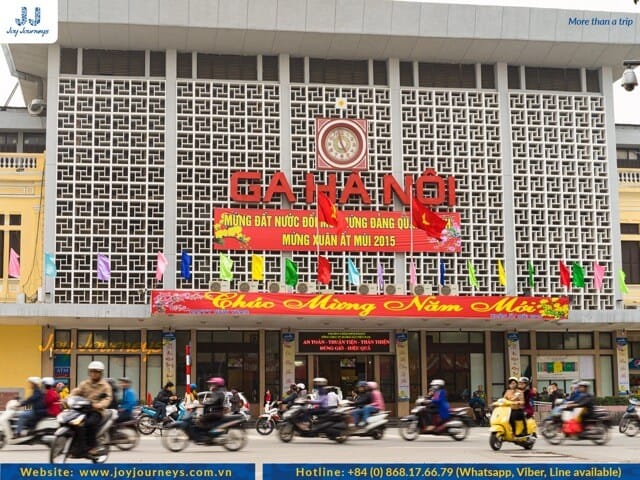
The ancient temples and pagodas of the Old Quarter, the historic Ho Chi Minh Mausoleum, and the spectacular French colonial structures of the French Quarter are all must-sees in Hanoi.
Other famous Hanoi sights include Hoan Kiem Lake, the Temple of Literature, and the bustling night markets.
Vietnam Train Street is the must-check-in location in Hanoi. Train Street is a narrow lane in Hanoi’s Old Quarter that runs alongside a railway track through a heavily populated neighborhood.
The street is noted for its distinct and lively ambiance, with locals and visitors congregating to watch trains pass by just inches away from houses and businesses.
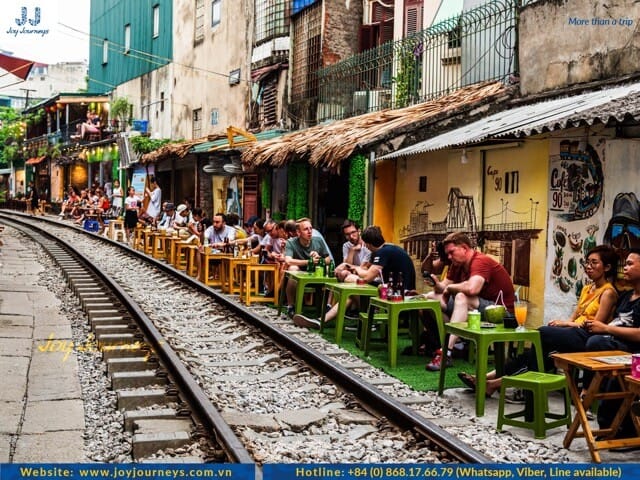
Hue Station
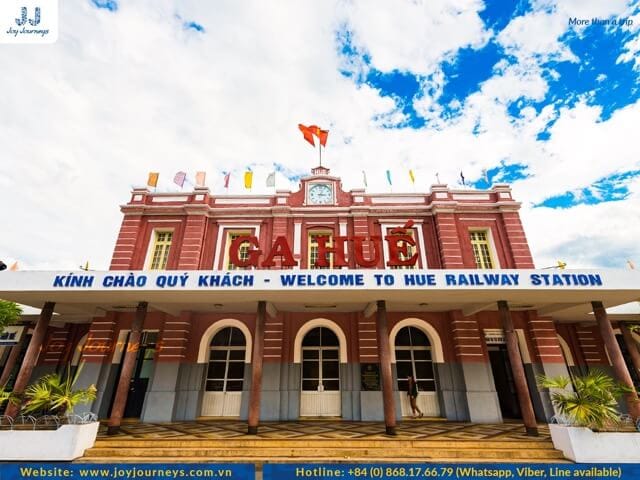
Hue, a city known for its imperial past and architecture, is the next stop. The old citadel, with its palaces, temples, and tombs of the Nguyen emperors, is open to visitors.
The citadel is encircled by a moat and tall walls, and it is separated into sections such as the Imperial City, the Forbidden Purple City, and the Royal Tombs.
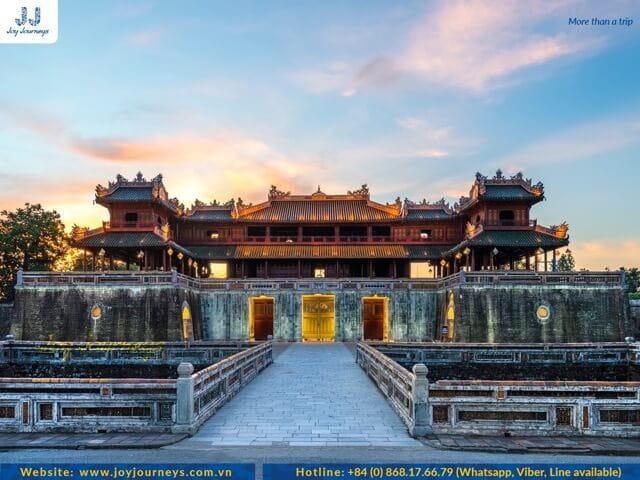
The landmark Thien Mu Pagoda, which overlooks the Perfume River, and the Dong Ba Market, which sells various local items and handicrafts, are popular sights in Hue.
Da Nang Station
The Vietnam train next passes Da Nang, a city known for its stunning scenery and beaches. Visitors can take in the spectacular vistas of the Marble Mountains, a cluster of five limestone and marble hills named after one of the universe’s five elements, and visit the ancient Cham ruins at My Son Sanctuary, all easily accessible by Vietnam train.
Da Nang also has some of Vietnam’s most stunning beaches, such as My Khe Beach and Non Nuoc Beach, which provide a variety of water sports and activities.

Visitors can also take a day trip to Bana Hill, a mountain resort noted for its breathtaking vistas and unusual attractions, such as the famed Golden Bridge.
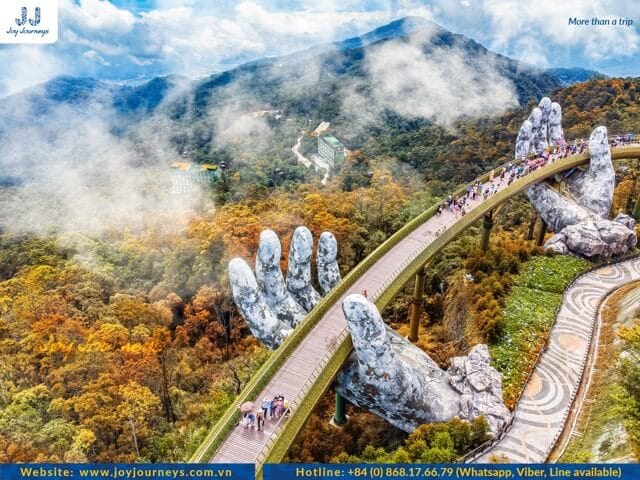
The bridge is a 150-meter-long pedestrian footbridge supported by enormous hands sprouting from the rock. There is also a French-style village, a wax museum, and an amusement park at the resort.
Nha Trang Station
The Vietnam train then arrives in Nha Trang, a beach city famed for its peaceful ambiance and crystal clear waters, making it a must-visit destination for those traveling by train in Vietnam.
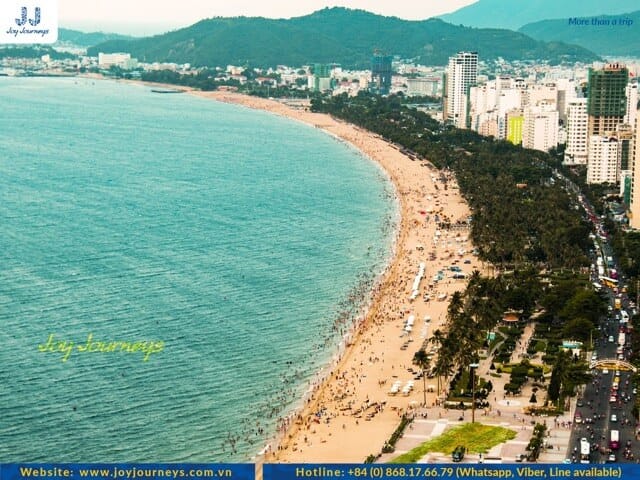
Visitors may unwind on the beaches, explore the historic Po Nagar Cham Towers, dating back to the 7th century, and see the Long Son Pagoda, which houses a massive white Buddha figure.

There are several museums in Nha Trang, including the Alexandre Yersin Museum and the National Oceanographic Museum of Vietnam.
Ho Chi Minh City Station
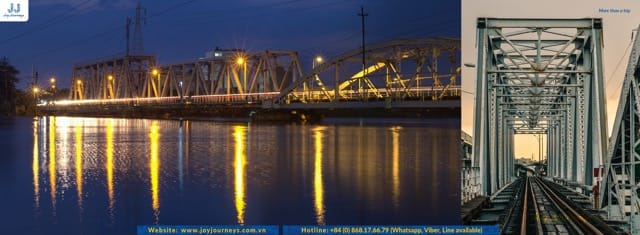
Ho Chi Minh City, formerly known as Saigon, is the final stop, a bustling metropolis with a lively culture and a rich history. Popular tourist attractions include the Reunification Palace, Notre Dame Cathedral, and the Ben Thanh Market.
The War Remnants Museum provides a sobering look into the Vietnam War. The Cu Chi Tunnels, a network of underground tunnels used by the Viet Cong during the conflict, are also popular attractions in Ho Chi Minh City.
The North-South Railway Line provides a remarkable journey through some of Vietnam’s most renowned places, allowing visitors to immerse themselves in the country’s rich culture, history, and natural beauty.
In big cities, the most convenient means of transportation is taxi.
What to Expect on the Train
Traveling by Vietnam train is a unique and relaxing way to experience the country’s different landscapes and cultures.
The Vietnam train network provides various services and accommodations to make your ride comfortable and enjoyable.
Here are some things to look forward to if you travel by Vietnam train in Vietnam.

Types of trains and classes: The North-South Railway Line operates various trains, including local trains, express trains, and the historic Reunification Express. The trains in Vietnam have several classes, ranging from basic hard seats to air-conditioned soft-sleeper cabins. The train categories offer varying levels of luxury and amenities, so selecting the class that best meets your demands and budget is critical.
Seating and sleeping options: The seating and sleeping options on the train vary depending on the class of train you choose. Hard seats are the most basic option, with seats arranged in rows facing each other. Soft seats are more comfortable, with seats arranged in pairs and more legroom. Soft-sleeper cabins are the most comfortable option, with private cabins that can accommodate up to four people. The cabins have comfortable beds, bedding, and curtains for privacy.
Food and beverage services: Food and beverage services are available on most trains, with a range of local dishes and snacks available for purchase. Some trains also offer dining cars, where passengers can enjoy a meal while enjoying the scenery. It’s also common for vendors to board the train at some stops, selling a range of local snacks and drinks.
Safety and comfort measures: Vietnam’s train network has a solid safety reputation with contemporary trains and well-maintained rails. Trains include air conditioning, fans, and windows that can be opened to allow for ventilation. Bedding and towels are provided in soft-sleeper cabins, and toilets and sinks are available on board. Keep your valuables and take the appropriate precautions to guarantee a safe and comfortable journey.
Traveling by train in Vietnam is a comfortable and convenient way to explore the country’s diverse landscapes and cultures. With a range of classes, seating and sleeping options, food and beverage services, and safety and comfort measures, the train network in Vietnam offers a unique and memorable travel experience.
There is no Uber in Vietnam, so if you want to book a ride-hailing service, Grab is the best choice!
Tips for Traveling by Train in Vietnam
The train is a unique and comfortable method to experience Vietnam’s different landscapes and cultures. Here are some pointers and suggestions for visitors wanting to take the train in Vietnam:
Booking tickets and choosing seats
Booking your train tickets in advance, especially during peak travel periods. You can book tickets online or at train stations, travel agencies, or hotels.
When choosing your seat, consider the class of train you want to travel on, the duration of the journey, and your budget. First class sleeper train cabins (Soft-sleeper cabins) are the most comfortable option for long journeys, while soft seats are a good option for shorter trips.
Here’s an approximate range of Vietnam trains from Hanoi to Ho Chi Minh ticket prices for different classes:
- Hard seats: 680,000 – 760,000 VND (30 – 35 USD)
- Soft seats: 1,026,000- 1,046,000 VND (43.67 – 44.52USD)
- Hard-sleeper cabins: 1054000 – 1,303,000 VND (44.86 – 55.46 USD)
- Soft-sleeper cabins: 1,237,000 – 1,578,000 VND (52.65- 67.16USD)
You can book train tickets here
Please keep in mind that these rates are estimates and may vary depending on a variety of criteria, such as train class, journey duration, and time of year. Furthermore, rates might fluctuate, so confirming the most recent ticket costs and availability with the train operator or travel agent is essential.
Packing and preparing for the journey
Pack comfortable clothing, warm layers, and a travel cushion or blanket for your train journey. Pack snacks and beverages for the trip, as food and beverage options on board may be restricted.
Bring a luggage lock and keep your valuables with you at all times. Packaging a book, music, or other entertainment for the trip is also good.
Safety and security measures
Vietnam train travel is typically safe. However, measures must be taken to guarantee a safe and comfortable voyage. Maintaining awareness of your surroundings, especially when boarding or disembarking from the train. Any suspicious behavior should be reported to training staff or authorities.
Cultural Etiquette and Considerations
Following local customs and etiquette is critical when taking the train in Vietnam. When entering the train, remove your shoes and consider other passengers’ space and privacy. Avoid having loud conversations or listening to music that may disturb other passengers. Understanding local customs and traditions is crucial, particularly while visiting temples or other cultural places.

Following these tips and advice can ensure a safe and comfortable journey and make the most of your travel experience.
Conclusion
In conclusion, Vietnam train has played an important part in Vietnam’s cultural and economic history. The train has enabled the flow of products and people across the country, from the initial railroad building in 1881 to the development of the North-South railway line in the 1930s. It is still a vital form of transportation today.
The train provides a unique and pleasant way to discover Vietnam’s diverse landscapes and cultures, with stops in classic sites such as Hanoi, Hue, Da Nang, Nha Trang, and Ho Chi Minh City. Travelers can experience Vietnam’s rich history, natural beauty, and dynamic culture uniquely and memorably by taking the train.
Frequently Asked Questions
Q: Are there trains in Vietnam?
A: Trains do exist in Vietnam. Vietnam has a railway network that connects major cities and towns across the country.
Q: Can you travel by train in Vietnam?
A: Train travel is possible in Vietnam. It’s an inexpensive and convenient way to travel around the country, allowing you to view the gorgeous countryside.
Q: How to book train tickets in Vietnam?
A: Train tickets in Vietnam can be purchased in a variety of ways. Tickets can be purchased online on the Vietnam Railways website (dsvn.vn) or through third-party booking sites such as Baolau or 12go.asia. Tickets can also be purchased in hand at major city railway stations or ticket offices.


Related Posts
Saigon’s “Flower Market Replica”: Where To Find Them
Ho Chi Minh City’s floral charm is not limited to its bustling wholesale markets. Imagine wandering through a place where vibrant petals, fragrant blooms, and the spirit of traditional Vietnamese markets come alive—without the overwhelming crowds. A flower market replica captures that magic, blending the beauty of fresh flowers with the charm of a curated, […]
Is it Safe to Travel to Vietnam Right Now? A Complete 2025 Guide
Vietnam has emerged as one of Southeast Asia’s most captivating destinations, drawing millions of visitors annually with its rich culture, stunning landscapes, and incredible cuisine. However, many travelers still ask: Is it safe to travel to Vietnam right now? This comprehensive guide provides you with everything you need to know about Vietnam travel safety in […]
Ho Chi Minh Cu Chi Tunnels Tour: The Ultimate Guide
The Cu Chi Tunnels stand as one of Vietnam’s most remarkable historical sites, offering visitors a profound glimpse into the ingenuity and resilience displayed during the Vietnam War. For travelers, a Ho Chi Minh Cu Chi tunnels tour represents an essential experience that combines education, adventure, and deep cultural understanding. This comprehensive guide will help […]